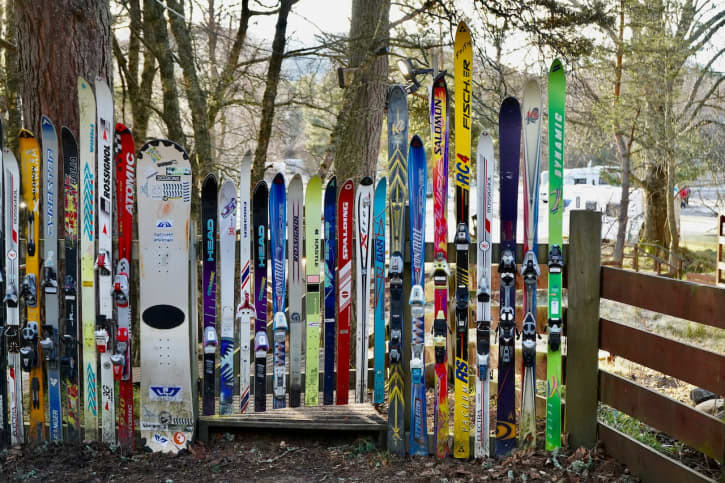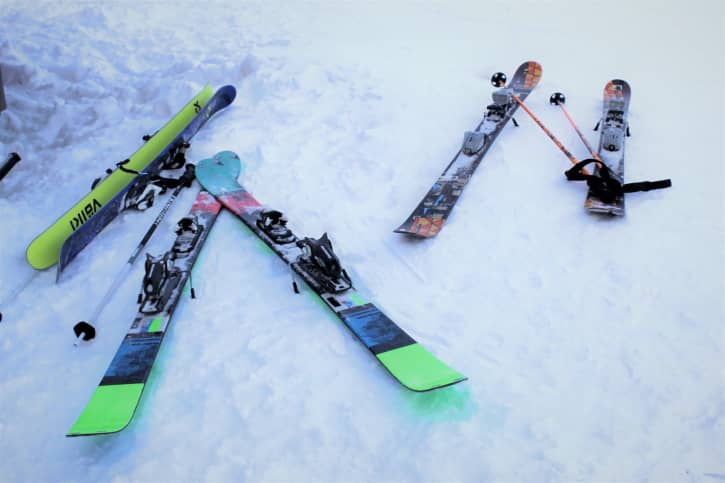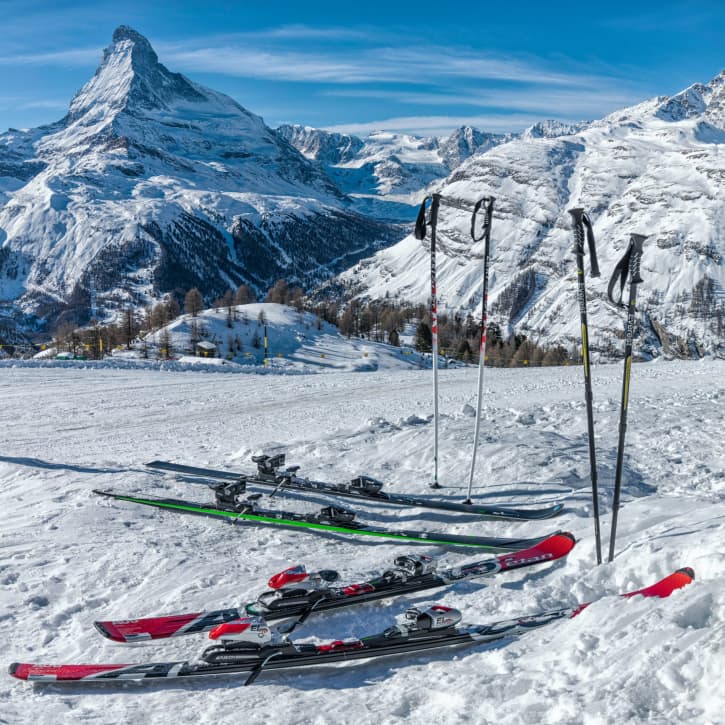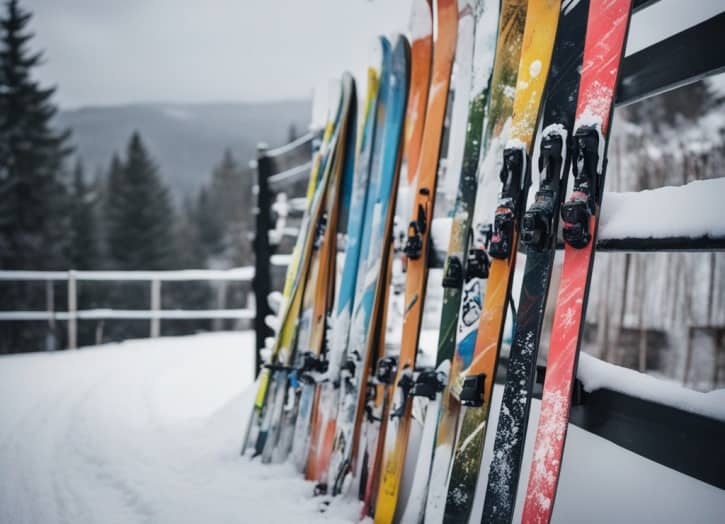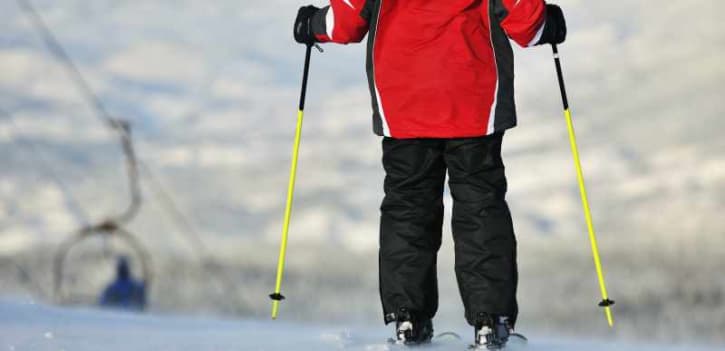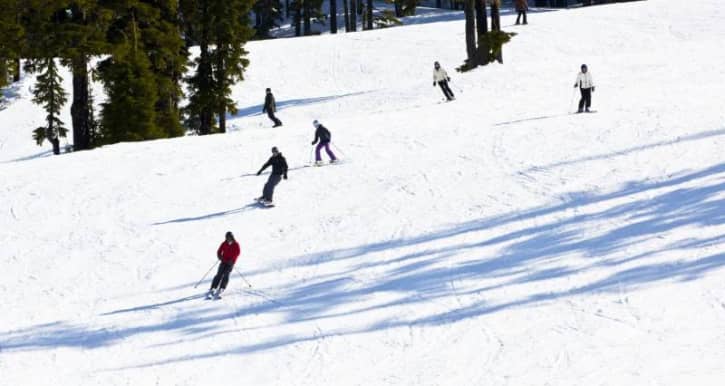Have you ever wondered how much skis weigh when you go on a ski trip? Or you might wonder, “Is ski weight light or heavy better for you?” Ski weight does have an impact on your skiing experience. It influences your performance, maneuverability, and overall enjoyment of your ski trip. In this guide, we’ll look at ski weight and how it affects your skiing adventures.
While it may not have crossed your mind, knowing how much a pair of skis weigh can help you choose the best equipment for your specific needs. We’ll talk about why some skis are heavy while others are light and offer practical advice to improve your skiing experiences.
Contents
How Much Do Skis Weigh?
Ski Weight Classifications
Skis can be organized by average weight, providing guidance on selecting the right skis for your needs. Classifications vary depending on manufacturers and models, but generally fall into the following categories:
- Ultralight Skis
- 2.2 to 2.9 pounds per ski (165 cm length)
- Ultralight skis are designed for ski mountaineering, ski touring, and backcountry adventures where weight is critical for efficient uphill travel. These skis prioritize lightness and agility, making them ideal for long ascents and challenging terrains.
- Lightweight Skis
- 2.8 to 3.6 pounds per ski (170 cm)
- Lightweight skis are versatile and suitable for various skiing styles and terrains. They offer a good balance between uphill efficiency and downhill performance, good for all-mountain and backcountry. Beginner and intermediate skiers should consider skis that are lightweight.
- Midweight Skis
- 3.4 to 4.2 pounds per ski (175 cm)
- Midweight skis blend stability, maneuverability, and performance. Some of the best skis for intermediate and advanced skiers are midweight. This is because they facilitate a well-rounded skiing experience on and off-piste.
- Heavyweight Skis
- 4.0 to 5.2 pounds per ski (180 cm)
- Heavyweight skis prioritize stability, edge hold, and dampening at high speeds. They are for aggressive skiers, advanced racers, and those who prefer carving on groomed runs.
The classifications are approximate ranges and can vary. What’s more important is the materials, intended use, and long skis vs. short skis, but being aware of these classifications should help narrow down your options for the best skis for you.
Next, let’s explore how much different kinds of skis weigh.
Weights of Different Types of Skis
Skis come in various types, tailored to specific styles and terrains. Here are the approximate average weights for some common ski categories:
- All-Mountain Skis
- 3.6 to 4.5 pounds per ski (163 cm long)
- All-mountain skis are versatile and designed to perform well on a variety of snow conditions and terrains. They strike a balance between groomed runs, powder, and off-piste terrain, making them an excellent choice if you want to explore different aspects of the mountain.
- Powder Skis
- 4.5 to 6.5 pounds per ski (175 cm)
- Powder skis are wider and provide ample floatation in deep snow. They have a larger surface area to keep you on top of fresh powder.
- Carving Skis
- 3.0 to 4.0 pounds per ski (160 cm)
- Carving skis are designed for on-piste skiing and are known for their excellent edge grip and responsiveness. They are narrower and more lightweight, making them ideal for quick and precise turns on groomed runs.
- Backcountry Skis
- 2.8 to 4.0 pounds per ski (170 cm)
- Backcountry skis are specifically designed for off-piste and adventurous skiing. They are lighter to make uphill travel more manageable during ski touring, yet they still offer decent performance for downhill skiing.
- Freestyle Skis
- 3.2 to 4.2 pounds per ski (170 cm)
- Freestyle skis are built with terrain parks in mind. They are often lighter and more maneuverable, allowing skiers to perform tricks, jumps, and spins.
- Alpine Touring Skis
- 2.8 to 4.0 pounds per ski (170 cm)
- Alpine touring skis (AT skis) are specifically designed for ski touring and climbing mountains. They are lighter to facilitate uphill travel and may have special features for attaching climbing skins.
Next, we’ll explore lightweight ski options for beginners and intermediates, or if you love exploring untouched snow in the backcountry.
See Also: Beginner Skis: 7 Things You Must Know Before Buying Your First Skis
Lightweight Ski Options for Backcountry Skiing
Backcountry skiing offers a thrilling escape into untouched snow and serene landscapes. You will need equipment that won’t weigh you down during ascents. Lightweight skis designed for backcountry adventures can significantly enhance your touring experience. Here are some popular lightweight skis tailored for backcountry skiing:
- Blizzard Rustler 9
- 4.3 pounds per ski (180 cm length)
- The Rustler Blizzard Rustler 9 (ad) stands as the narrowest ski in the Rustler line. It features a Titanal laminate along the entire cambered area, complemented by the TrueBlend Free Core, a fusion of Beech, Poplar, and Paulownia woods. As a reliable one-ski quiver, it shines in carving, floating, and all-mountain conditions.
- Dynafit Blacklight Series
- 2.4 to 3.3 pounds per ski (165 cm)
- The Dynafit Blacklight (ad) Series is renowned for its exceptional lightness without compromising downhill performance. These skis are engineered with carbon fiber construction, making them ideal for efficient climbing and nimble descents in the backcountry.
- Atomic Backland 95
- 2.6 to 3.7 pounds per ski (175 cm)
- The Atomic Backland 95 (ad) skis balance weight and versatility. They feature a lightweight wood core and carbon backbone for stability during descents and are well-suited for powder and mixed snow conditions.
- G3 FINDr Series
- 2.6 to 3.4 pounds per ski (172 cm)
- The G3 FINDr Series has a lightweight Paulownia wood core and carbon fiber construction. These skis excel in steep terrain and aid performance on challenging ascents and thrilling descents.
- Blizzard Zero G Series
- 3.0 to 3.7 pounds per ski (171 cm length)
- The Blizzard Zero G (ad) Series focuses on lightweight construction, utilizing a Paulownia wood core and carbon frame for easy climbing and enjoyable descents in the backcountry.
Pairing these skis with lightweight touring bindings and boots can further enhance your backcountry skiing experience.
Now let’s explore the other end of the spectrum and discover heavyweight skis tailored for racing.
Heavyweight Skis for Downhill Racing
Heavyweight skis are engineered for top-notch stability and precision. They are for adrenaline-seeking downhill racers looking to dominate the slopes. These skis handle high speeds and aggressive turns, making them ideal for competitive racing scenarios. Here are some noteworthy heavyweight skis and how much they weigh.
- Fischer RC4 Worldcup GS
- 8.6 to 9.7 pounds per pair (188 cm)
- The Fischer RC4 Worldcup GS (ad) skis are precision instruments for aggressive racers. They have a wood core, titanal reinforcement, and a World Cup base. These skis provide lightning-fast responsiveness and unparalleled stability during high-speed races.
- Rossignol Hero Elite
- 9.2 to 10.4 pounds per pair (175 cm)
- The Rossignol Hero Elite (ad) skis are engineered for advanced skiers who demand precise control and rapid edge-to-edge transitions. These skis feature titanal construction for superior stability and energy transmission.
- Atomic Redster G9
- 8.8 to 10.1 pounds per pair (185 cm)
- The Atomic Redster G9 (ad) skis are designed for aggressive skiers who thrive on carving fast and precise turns. These skis boast a Full Sidewall construction and titanium layers, delivering exceptional power and stability.
- Nordica Dobermann GS
- 9.6 to 10.7 pounds per pair (182 cm)
- The Nordica Dobermann GS skis are built for aggressive racers who demand precise performance. With a full titanal construction and aggressive race profile, these skis deliver exceptional power and responsiveness.
Heavyweight skis are specifically designed for advanced and expert skiers with the skills to handle their high-performance characteristics. They will be less forgiving if you are a beginner or casual skier.
When selecting downhill racing skis, you must consider your skill level, racing goals, and the specific race discipline you’ll be participating in, whether it’s slalom, giant slalom, or super-G. The right combination of ski length and stiffness can make a big difference in optimizing your performance on the racecourse.
Now that we’ve explored both lightweight and heavyweight skis, let’s look at what makes skis lighter or heavier.
Factors that Contribute to Ski Weight
The weight of a pair of skis depends on several things. Here are the key elements that contribute to how much skis weigh:
Materials
The materials used in constructing skis impact their weight. Skis are made out of a combination of materials like wood, metal, fiberglass, carbon fiber, and various composites. Skis with metal layers are heavier but provide better stability at high speeds, while skis with more carbon fiber tend to be lighter and offer enhanced maneuverability.
Long Skis vs. Short Skis
This may surprise you, but longer skis weigh more than shorter ones. The length of the ski means more material is used in its construction, thus influencing its overall weight. Longer skis provide better stability in deep snow, but shorter skis allow quick turns and agility.
Ski Width
The width of the ski, particularly at the tip, waist, and tail, plays a role in its weight as well. Wider skis designed for powder skiing are heavier due to the extra material of a larger surface area. On the other hand, narrower skis, like those used for carving on groomed slopes, are generally lighter.
Ski Design and Construction
The overall design and construction of the ski impact its weight and performance. Skis designed for specific styles of skiing, such as all-mountain, backcountry, freestyle, or racing, are tailored to meet the demands of those activities. Each design may incorporate different materials and construction methods, resulting in varying ski weights.
Brand and Model
Different ski manufacturers have their own unique approaches to crafting skis. Some brands prioritize lightweight designs, while others focus on durability and performance, which may lead to slightly heavier skis. Additionally, within each brand’s lineup, specific models might be lighter or heavier depending on their intended use and target audience.
Binding and Mounting
The bindings you choose and their mounting position on the skis can influence the overall weight. High-performance bindings and complex mounting systems might add some weight to the skis.
Considering these aspects can help you choose the best skis for your skiing style and preferences. Next, let’s look at whether light or heavy skis are better for you.
Is Ski Weight Light Or Heavy Better For You?
How Ski Weight Affects Performance
Here are some ways that how much skis weigh can influence your performance on the slopes:
- Maneuverability and Responsiveness
- Lightweight Skis: Lighter skis are more maneuverable and responsive. They are easier to turn, making them ideal for quick movements. They are for skiing in trees, moguls, and tight spaces where precise control is essential.
- Heavyweight Skis: Heavier skis may feel less nimble, requiring more energy and effort to initiate turns. However, they offer more stability and hold their edge better at high speeds, providing a smooth ride on groomed runs and steep slopes.
- Floatation in Powder
- Lightweight Skis: In deep powder, wider and lighter skis can provide better floatation, allowing you to glide on top of the snow rather than sinking in. This enables easier turns and a more enjoyable experience in fresh snow conditions.
- Heavyweight Skis: Heavier skis with more surface area can also offer good floatation in powder, but they may require stronger skiers to maintain control in challenging conditions.
- Stability and Dampening
- Lightweight Skis: Lighter skis can feel more playful and lively but might lack the stability and dampening needed to absorb vibrations on rough or icy terrain.
- Heavyweight Skis: Heavier skis often provide better stability and dampening, reducing chatter and vibrations at higher speeds. This can be particularly advantageous if you are an advanced skier tackling aggressive terrains and challenging conditions.
- Energy Efficiency during Climbing
- Lightweight Skis: When ski touring or backcountry skiing, lighter skis reduce the strain on your legs during ascents, allowing you to conserve energy for longer journeys and more runs.
- Heavyweight Skis: Heavier skis can feel more cumbersome during uphill travel, potentially requiring more effort and stamina.
- Edge Grip and Carving Performance
- Lightweight Skis: Lighter skis might have slightly less edge grip on icy or hard-packed slopes, affecting their carving performance at high speeds.
- Heavyweight Skis: Heavier skis excel in carving due to their increased stability and improved edge hold on firmer snow.
The best skis for intermediate skiers and beginners are lightweight since they balance agility and maneuverability. Expert skiers may opt for heavyweight skis to maximize stability and performance in challenging conditions.
Tips for Choosing the Right Ski Weight for Your Needs
How can you tell if ski weight, light or heavy, is better for you? Consider your skiing ability and what kinds of runs you like. You can demo skis and talk to ski pros. Knowing if ski weight light or heavy is better for you can allow you to have more fun on your ski trip.
Here are some tips to help you find the best ski weight:
- Assess Your Skiing Ability: Consider your skiing level and experience. Lightweight skis are generally more forgiving, so they are the best skis for intermediate and beginner skiers. You will be able to turn and maneuver better in lightweight skis. Heavier skis are better if you are an expert skier seeking enhanced stability and control at higher speeds.
- Identify Your Preferred Terrain: Think about the kinds of runs you usually take. If you explore off-piste and backcountry areas, lightweight skis can make uphill travel more manageable and offer better floatation in powder. For groomed runs and aggressive turns, heavier skis provide the stability and edge hold you need.
- Factor in Your Skiing Style: Consider your skiing style and preferences. Lighter skis can be more responsive and agile for tight turns, moguls, and quick maneuvers. Heavier skis offer the stability and dampening required for high-speed carving or aggressive downhill racing.
- Be Mindful of Your Physical Condition: Assess your physical condition and stamina, especially if you plan on ski touring or backcountry skiing. Lighter skis can reduce fatigue during ascents, but heavier skis might provide more stability and control during challenging descents.
- Research Different Ski Models: Explore various ski models and brands to find those that match your skiing needs. Manufacturers often offer skis with different weights and constructions within their product lines, catering to different styles and skill levels.
- Demo Skis Whenever Possible: If possible, demo or rent skis before purchasing. Trying out different ski weights on the snow will give you a better understanding of how they feel and perform, helping you make an informed decision.
- Seek Expert Advice: Consult with experienced skiers, ski instructors, or knowledgeable staff at ski shops. They can offer valuable insights and recommendations based on your skiing goals and requirements.
- Consider Ski Technology: Stay informed about the latest ski technology advancements. Ski manufacturers continually innovate to create lighter and high-performing skis, so keeping up with the latest developments can help you find the most suitable weight for your skis.
- Don’t Forget Bindings and Boots: Remember that the combined weight of your skis, bindings, and boots impacts your overall skiing experience. Opt for lightweight bindings and boots that complement your chosen ski weight.
- Test in Different Conditions: If possible, test your chosen skis in various snow conditions and terrains. Understanding how the skis perform in different scenarios will give you a comprehensive assessment of their suitability.
Next, let’s address some misconceptions about the weight of skis.
Common Misconceptions about Ski Weight
Understanding how much skis weigh and determining whether ski weight light or heavy is better for you can help you select the most suitable skis for you specifically. Let’s debunk some common misconceptions:
Heavier Skis are Always Better for Downhill Performance. While heavier skis can provide stability and dampening at high speeds, it’s essential to match the weight of your skis with your skiing abilities and preferred terrain. For expert skiers and aggressive downhill racing, heavier skis are advantageous. Lightweight skis are generally the best skis for intermediate and advanced skiers in various conditions.
Lighter Skis Lack Durability. Advances in ski technology have created durable, high-performing, lightweight skis. Many lightweight skis incorporate materials like carbon fiber and reinforced cores to maintain durability without excessive weight.
Heavier Skis are More Difficult to Control. The control of skis depends on various factors, including ski length, design, and individual skill level. While heavier skis may provide stability, advanced skiers can effectively control lighter skis with proper technique and skill.
Lighter Skis Cannot Handle Aggressive Terrain. Lightweight skis designed for backcountry or touring are optimized for efficient climbing. But they can still handle challenging terrain with proper technique. Many experienced backcountry skiers prefer lightweight skis for their versatility and maneuverability.
How Much Skis Weigh Doesn’t Affect Uphill Efficiency. The weight of your skis significantly impacts your uphill performance during ski touring or backcountry skiing. Lighter skis reduce fatigue and make uphill travel more manageable, enhancing overall efficiency.
Ski Weight Only Affects Experts, Not Beginners. How much your skis weigh is relevant to skiers of all levels. Beginners benefit from lighter skis that are easier to control and maneuver, while advanced skiers can find optimal performance with heavier skis designed for aggressive skiing.
All Lightweight Skis are Suitable for Backcountry Skiing. Not all lightweight skis are created equal. Specific backcountry ski models have the features necessary for touring, such as skin attachments and optimal floatation in deep snow.
Heavier Skis Are Always More Expensive. Ski prices vary based on various factors, including brand, materials, and construction. While high-performance skis can come with a hefty price tag, both lightweight and heavyweight skis are available at various price points.
Now that we’ve dispelled these myths, let’s wrap up our comprehensive guide with some final thoughts.
Conclusion and Final Thoughts
This article looked at ski weight and how it affects skiing performance and enjoyment. It dispelled common misconceptions and emphasized the importance of matching ski weight with individual preferences and skill levels. Both lightweight and heavyweight skis have unique advantages, and the ideal ski weight depends on a number of factors.
Lightweight skis provide excellent maneuverability and efficiency for beginners, intermediates, and backcountry adventures. Heavyweight skis offer stability and control for downhill racers and advanced skiers. Choose the right weight based on your ability, skiing style, and the latest technology. Demoing skis and seeking advice from experienced skiers can help you find the perfect match.
Ski manufacturers continuously innovate in the industry, creating lightweight yet high-performing skis. The latest advancements ensure the best ski gear for your adventures. Choose the right skis for a great trip, exploring new trails, and creating unforgettable memories.
Happy skiing!

